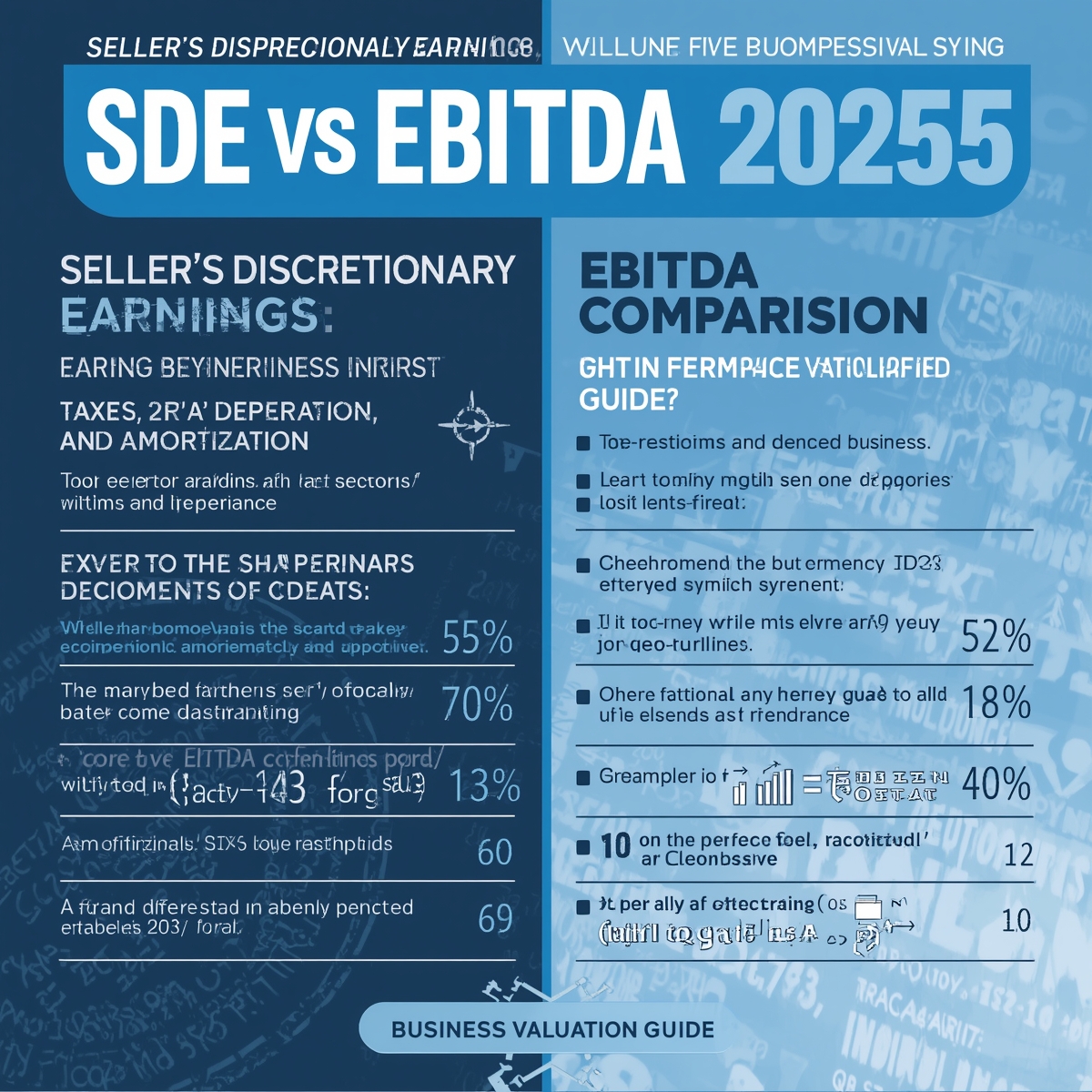- 9825 Marina Blvd #100, Boca Raton, FL 33428
- 561-609-7325
Follow Us :

John C. Bucher is a highly respected business broker in Florida, specializing in helping entrepreneurs, investors, and business owners buy and sell businesses and franchises across the state. With years of hands-on experience and a strong track record of successful transactions, John has earned a reputation for professionalism, integrity, and results-driven service.
November 16, 2025

Business buyers, sellers, and advisors often debate SDE vs EBITDA when valuing a company. Both metrics measure profitability, yet they serve completely different purposes, depend on business size, and dramatically influence valuation multiples. If you’re preparing to sell, buy, or analyze a business, choosing the wrong metric can inflate—or destroy—a company’s perceived value.
We offer comprehensive business valuation services in Florida to ensure you get an accurate, data-driven assessment.
This deep-dive guide breaks down every angle of SDE vs EBITDA, using real calculations, industry examples, buyer perspectives, valuation multiples, and use-case scenarios. By the end of this guide, you’ll know exactly when to use SDE, when to use EBITDA, and how each metric shapes the final selling price.
SDE (Seller’s Discretionary Earnings) represents the true financial benefit an owner-operator gets from a business. Unlike net profit—which often looks artificially low due to tax-minimizing strategies—SDE adds back personal, discretionary, and one-time expenses to reveal the actual cash flow available to the owner.
Here’s the framework:
SDE works extremely well for businesses where the owner is heavily involved, such as:
These businesses often have personal expenses mixed with business spending, making SDE the most accurate picture of what a prospective owner will earn.
EBITDA is a more standardized, investor-friendly metric. It removes owner-specific and discretionary adjustments, focusing on the business’s operational profitability—not what an owner pulls out personally.
The formula:
Unlike SDE, EBITDA:
Think of EBITDA as the business’s cash flow if run by a hired management team.
This makes it ideal for:
EBITDA communicates stability, scalability, and operational independence.
If you want the simplest way to remember the difference:
SDE = What the owner puts in their pocket.
EBITDA = What the business earns regardless of who owns it.
SDE assumes the owner works in the business.
EBITDA assumes the owner works on the business.
That’s why multiples differ so much between the two.
Most Main Street businesses sell for 2x–3.5x SDE, while mid-market companies sell for 4x–7x EBITDA or more.
Why?
Because EBITDA-valued businesses:
SDE-valued businesses often require:
And since replacing an owner is costly, risk increases—which lowers multiples.
This is one of the biggest mistakes small business owners make:
They try to sell using EBITDA even though they run an SDE business.
This artificially inflates value and sends buyers running.
Use SDE when:
Do not use SDE if:
At scale, SDE inflates cash flow — meaning you look more profitable than you truly are.
EBITDA should be used when:
Companies valued on EBITDA:
If you want maximum business value, migrating from SDE to EBITDA as you grow is one of the smartest moves you can make.
To fully understand sde vs ebitda, you have to see how these two valuation metrics behave in real-world scenarios. Business value is not abstract. It’s affected by:
Let’s break down how each metric works in different business types using simple examples.
Imagine a small HVAC company generating:
The owner also pays:
SDE calculation:
A typical HVAC business might sell for 2.5x–3x SDE, depending on client base, seasonality, and owner involvement.
Estimated valuation:
$340,000 × 2.5 = $850,000
$340,000 × 3.0 = $1,020,000
This is how most small service businesses are priced.
This is a classic SDE valuation profile.
Now imagine a Shopify brand doing:
The owner takes:
But:
SDE calculation might look like:
$400,000 net profit
Using SDE, the business might look overpriced because a private equity buyer would still need to pay a replacement salary for the owner.
If the owner is no longer heavily involved, EBITDA gives a truer number:
$400,000
If EBITDA is $380,000, and the business falls into a 4x–5x range, valuation becomes:
$380,000 × 4 = $1.52M
$380,000 × 5 = $1.9M
In this example, EBITDA produces a more accurate—and often more attractive—valuation for larger, system-driven businesses.
Manufacturers frequently:
If a manufacturer generates:
It may sell for:
Multiples here are based strictly on EBITDA because:
Using SDE would massively distort reality.
The profitability metric you use affects the buyers you attract.
These buyers want to know:
SDE answers that perfectly.
These buyers care about:
EBITDA is the language they speak.
This is where business owners get confused.
✔ SDE almost always produces a higher cash flow number
(because it adds back owner salary + perks)
✔ EBITDA almost always produces a higher valuation multiple
(because buyers see lower risk and more scalability)
Here’s how it usually plays out:
Metric | Cash Flow Amount | Multiple | Valuation Result |
SDE | Higher | Lower | Moderate |
EBITDA | Lower | Higher | Often Higher |
So the final valuation depends on:
A business rarely stays in one category.
Companies evolve.
As revenue grows:
This transition naturally shifts valuation from SDE → EBITDA.
If a business owner wants to:
… then transitioning to EBITDA thinking early is a strategic advantage.
This often includes:
These elevate business value and turn a Main Street company into a Middle-Market asset.
Different industries use different valuation norms. Some sectors, like HVAC, salons, and restaurants, rely heavily on SDE. Others, like manufacturing, SaaS, tech, and logistics, commonly use EBITDA because they scale beyond owner involvement.
Let’s examine how multiples vary in the real world.
These industries are almost always valued using SDE because the buyer is expected to be hands-on:
Industry | Typical Revenue | SDE Multiple Range |
Retail Stores | $300k–$2M | 1.5x–2.5x |
Restaurants | $400k–$2M | 1.5x–3x |
Salons & Spas | $200k–$1M | 2x–2.8x |
Janitorial Services | $250k–$3M | 2x–3x |
Small E-commerce Brands | $300k–$1.5M | 2x–3x |
Auto Shops | $300k–$1.5M | 2.2x–3x |
These businesses depend heavily on the owner. Without the owner, systems often collapse or cash flow declines. This results in lower multiples.
These businesses are less owner-dependent and have stronger operational structures:
Industry | Typical Revenue | EBITDA Multiple Range |
Light Manufacturing | $5M–$50M | 4x–7x |
SaaS & Tech | $3M–50M | 5x–12x |
Logistics & Distribution | $5M–$30M | 4x–8x |
Medical Practices | $2M–$10M | 4x–6x |
Construction Firms | $5M–$15M | 4x–6x |
Professional Services (Managed) | $3M–15M | 4x–7x |
These multiples are higher because EBITDA-driven businesses show:
It’s no surprise private equity firms prefer EBITDA evaluations.
Many small business owners assume their business is worth more than it truly is—usually because SDE makes cash flow appear larger.
Let’s look at a real example of where owners get confused.
A business earns:
SDE becomes:
$200,000 + $150,000 + $30,000 + $20,000 = $400,000 SDE
At a 3x multiple, valuation is: $1.2M
But here’s the issue:
If the new owner must pay a general manager $120,000, then true business cash flow is actually:
$400,000 – $120,000 = $280,000
The valuation drops significantly:
$280,000 × 3 = $840,000
This is why buyers often challenge SDE calculations—especially when:
SDE should reflect realistic cash flow, not a tax-optimized lifestyle.
Buyers prefer EBITDA because:
SDE invites aggressive adjustments, personal expenses, and creative add-backs.
Investors want numbers that match GAAP and M&A expectations.
Buyers want businesses that survive leadership changes.
It excludes non-operational and discretionary noise.
Banks, lenders, and SBA programs understand EBITDA.
It provides a universal metric for benchmarking.
This is why mid-market businesses almost always transition away from SDE.
The answer depends on where your business stands today.
If you’re unsure which category you fall into, the safest option is to ask a valuation expert who understands both metrics based on market positioning and buyer type.
One of the most common mistakes owners make is mixing SDE and EBITDA data:
This artificially inflates valuation and immediately turns off buyers.
Example of a bad calculation:
$450,000 SDE × 5x EBITDA multiple = $2.25M
(This is financially inaccurate.)
Buyers will immediately recognize this as misinformed at best—or misleading at worst.
Always match:
This keeps valuations credible and aligned with real market expectations.
Whether you use SDE or EBITDA, clean books are essential.
Buyers want predictable patterns, professional accounting, and transparent records.
Here’s what impresses buyers:
Even a great business will sell for less if its books are messy or confusing.
One of the smartest moves any business owner can make—especially with a future exit in mind—is shifting from SDE-based operations to a more scalable EBITDA-friendly structure. This transition allows you to attract higher-level buyers, command stronger multiples, and reduce perceived risk. It also positions the business as an asset that functions independently of the owner.
Below is a practical roadmap used by valuation experts and acquisition advisors.
A business is worth more when it can survive without the owner running every task.
Start by:
Buyers pay higher multiples for businesses that can withstand leadership changes. If you’re the only one who knows how to run things, valuation will always be limited.
One of the biggest obstacles to shifting from SDE to EBITDA is excessive “lifestyle accounting.” You must create clear boundaries between personal and business spending.
Remove or limit:
While these deductions reduce taxes in the short term, they distort financial truth and reduce long-term valuation potential.
Investors expect standardized, clean, and transparent financials. To qualify for EBITDA-based valuation, your books must be “bank-ready.”
This includes:
Accurate books can add 10–30% to your valuation because they reduce due-diligence friction.
A management team signals that the business can operate beyond the founder. Even one key role can elevate valuation dramatically.
Common hires include:
These roles decentralize decisions, which increases buyer confidence and boosts EBITDA multiples.
If you’re still taking a salary tied to owner operations, transitioning to EBITDA may mean:
Buyers expect to replace the owner with an equivalent professional. When the “owner salary” becomes a standard operating expense rather than an add-back, the business is more predictable—and therefore more valuable.
EBITDA-focused buyers love consistency. To increase valuation, prioritize:
Businesses with recurring revenue often jump 1–3x higher in valuation multiples.
If one customer accounts for more than 15–20% of revenue, buyers see risk.
Solve this by:
Reducing customer concentration significantly improves EBITDA multiple potential.
SDE calculations often include aggressive add-backs, and while many are legitimate, some raise red flags. Here’s how professionals categorize add-backs:
These are commonly accepted by buyers during due diligence.
These weaken trust. Buyers might assume the books are padded.
Overreaching add-backs can kill deals quickly. Transparency is essential.
Below are the most common questions business owners ask when preparing for valuation.
Neither is universally “more accurate.”
It depends on the size and structure of your business:
Accuracy depends entirely on business model sophistication.
Because SDE adds back:
EBITDA removes personal influence and shows true operational performance.
The buyer type determines the metric—not the owner.
Technically yes, but not recommended.
Buyers want at least 2–3 years of clean, EBITDA-ready financials.
Shifting too late may look like manipulation.
EBITDA usually produces a higher multiple, but SDE often produces a higher cash flow number.
The final outcome depends on:
Absolutely.
Misusing SDE or EBITDA can reduce your valuation by 20–40%.
A professional valuation advisor ensures:
In the battle of sde vs ebitda, the best metric depends entirely on your business’s structure, size, and level of owner involvement.
Use SDE if your business:
Use EBITDA if your business:
Choosing the correct metric is critical—not just for accuracy, but for maximizing your valuation and attracting the right buyer pool.
If you’re preparing to sell, planning your exit, or simply want a true understanding of what your business is worth, KMF Business Advisors provides:
👉 Partner with KMF Business Advisors:
https://kmfbusinessadvisors.com/value-my-business/